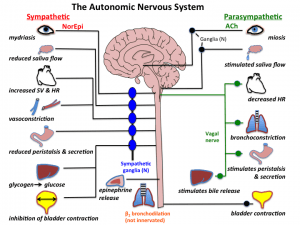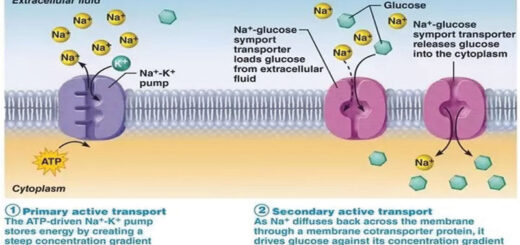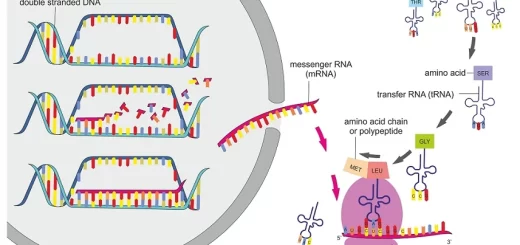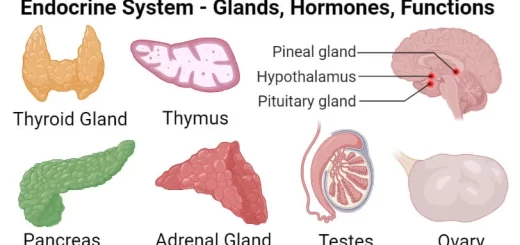Functions of Sympathetic nervous system & Role of the sympathetic in emergencies
The sympathetic nervous system makes up part of the autonomic nervous system, It is also known as the involuntary nervous system. It can regulate important bodily functions such as heart rate, blood pressure, pupil dilation, body temperature, sweating, and digestion, The sympathetic nervous system can direct the body’s rapid involuntary response to dangerous or stressful situations.
Sympathetic nervous system
The sympathetic division is also called the thoracolumbar division of the autonomic system because its preganglionic fibers exit the spinal cord, in the ventral roots of spinal nerves, from the first thoracic (T1) to the second lumbar (L2) levels.
The axons of these neurons reach the paravertebral sympathetic ganglion. (sympathetic chain). On entering the ganglionic chain, a preganglionic fiber may have one of three courses:
- It may pass up or down the chain to relay in a ganglion belonging to more superior or inferior segments.
- The preganglionic fibers may pass through the chain into the splanchnic nerves to reach the collateral ganglia (Coeliac, superior, and inferior mesenteric ganglia). The postganglionic fibers arising from these ganglia run with the blood vessels to supply the muscle of the abdominal and pelvic viscera, to the glands of the gut, and to the blood vessels of the abdominal viscera. The term splanchnic is usually used to describe organs in the abdominal cavity (visceral organs).
- Some preganglionic fibers of the splanchnic nerve directly innervate secretory cells of the adrenal medulla.
Functions of the sympathetic nervous system
I. Sympathetic supply to the head and neck: The sympathetic post-ganglionic fibers to the head and neck proceed along the branches of the carotid artery.
Functions
- Dilatation of eye pupil (mydriasis).
- Retraction of the eyelids and widening of the palpebral fissure.
- Protrusion of the eyeball (exophthalmos).
- Vasoconstriction of the blood vessels of the lacrimal gland.
- Trophic secretory fibers to salivary glands (secretion of viscid saliva, small in volume and rich in organic matter).
- Vasoconstriction of the blood vessels of the salivary glands.
- Motor to erector pilae muscles leading to an erection of hair in animals.
- Secretion of sweat due to stimulation of the sweat glands.
- Vasoconstriction in both cutaneous and deep vessels.
- The cerebral vessels: under normal physiological conditions sympathetic control has little influence on cerebral autoregulation. Its role is more evident under pathological conditions as hypertension.
II. Sympathetic supply to the thoracic viscera
Functions:
A. Heart: Excitation of all properties of the cardiac muscle e.g. increase heart rate and force of contraction. Vasodilator to coronaries, leading to increase the blood supply to the heart.
B. Lungs: Inhibitory to the plain muscle of the bronchi and bronchioles (bronchodilator). Slight vasoconstriction of the pulmonary blood vessels.
III. Sympathetic supply to the abdominal viscera
Preganglionic axons run via the greater splanchnic nerve to reach the postganglionic neurons in the collateral ganglia.
Functions:
- Vasoconstriction to the blood vessels of the abdominal viscera.
- Inhibitory to the smooth muscle of the wall of the gastrointestinal tract but motor to the sphincters.
- Glycogenolytic to the liver (conversion of liver glycogen into blood glucose), thus increasing the blood glucose level.
- Inhibitory to the smooth muscle of the wall of gall bladder but motor to its sphincter, leading to retention of bile.
- Motor to the smooth muscle of the splenic capsule leading to its contraction and squeezing of blood rich in RBCs into the circulation.
- Secretory to the adrenal medulla leading to secretion of adrenaline and noradrenaline in the blood.
IV. Sympathetic fibers to the pelvis
The postganglionic sympathetic fibers as lesser splanchnic nerve are carried with blood supply to the pelvic organs.
Functions:
- Inhibitory to the smooth muscle of the distal half of the colon and rectum but motor to the internal anal sphincter leading to retention of faeces.
- Inhibitory to the smooth muscle of urinary bladder and motor to the internal urethral sphincter leading to retention of urine.
- Vasoconstrictor to the blood vessels of pelvic viscera.
- Motor to the smooth muscle of male sex organs leading to ejaculation of semen.
- Variable effects on the smooth muscle of the uterus, i.e contraction, or relaxation depending on the stage of the menstrual cycle, the ovarian hormonal level, pregnancy, and other factors.
V. Sympathetic supply to the limbs, thoracic, and abdominal parties
Functions
- Vasoconstrictor to cutaneous blood vessels.
- Secretory to the sweat glands (by sympathetic cholinergic fibers).
- Motor to the erector pilae muscle causing erection of hair (in animals).
- Vasodilatation to the blood vessels of the skeletal muscles (sympathetic cholinergic fibers), leading to increased blood flow.
- Increase of muscle glycogenolysis.
Sympathetic tone
Under basal conditions, the sympathetic system is continuously active and discharges impulses to the innervated organs. The basal rate of activity of the sympathetic system is known as the sympathetic tone. Tonic sympathetic discharge to arterioles maintains arterial blood pressure and helps in the distribution of blood to the various tissues.
The overall role of the sympathetic in emergencies
In emergency as fight and flight, the sympathetic system prepares the body for activities and increases its capacity and endurance for performing severe muscular efforts.
Large portions of the sympathetic nervous system discharges at the same time that is, a mass discharge, it occurs when the hypothalamus is activated by fear or severe pain.
The result is a wide-spread reaction throughout the body, called the alarm or stress response. Sympathetic stimulation during the stress response produces the following effects:
- Dilatation of the pupil.
- Acceleration of the heartbeat, increases the force of myocardial contraction and raised blood pressure (providing better perfusion of the vital organs and muscles).
- Dilatation of the bronchioles to ensure better lung ventilation and more O2 supply to the tissues.
- Constriction of the blood vessels in the skin which limits bleeding in case of haemorrhage.
- The blood flow is shifted from the peripheral and unimportant organs as the skin and splanchnic areas to the important organs such as the heart, CNS, and skeletal muscles.
- Increased glycogenolysis in the liver.
- Elevation of blood glucose and free fatty acid level (supplying more energy).
- Contraction of the splenic capsule leading to the ejection of some blood rich in red blood cells into the circulation to increase blood volume and O2 carrying capacity of the blood.
- Secretion of adrenaline and noradrenaline from the adrenal medulla potentiate the stimulation of the sympathetic system.
- Increased strength of muscle contraction and delayed onset of fatigue.
- Increased mental activity and cellular metabolism throughout the body.
- Increased sweat secretion, which by its evaporation increases the heat loss from the body.
- Sympathetic discharge reinforces the alert aroused state by a central action of catecholamine on the reticular formation.
- The stem of these effects permits the person to perform far more strenuous physical and mental activities than would otherwise be possible.
- However, at other times sympathetic activation occurs in isolated portions of the system e.g.: In the process of heat regulation, the sympathetic control sweating and blood flow in the skin without affecting other organs innervated by the sympathetic nervous system.
Autonomic nervous system, Reflex action types & Autonomic ganglia function
Functions of parasympathetic nervous system, Antagonistic & Synergistic effects
Chemical transmission in Autonomic nervous system & Control of autonomic functions
Nervous system (Central nervous system, Peripheral nervous system & Autonomic nervous system)
Nervous system in man, Nerve cells types & Nature of nerve impulse




